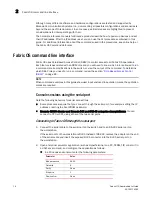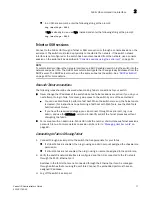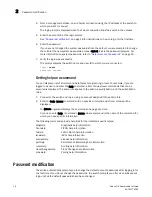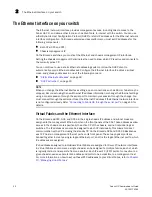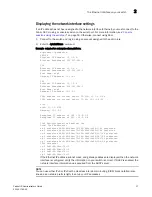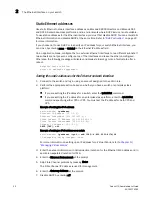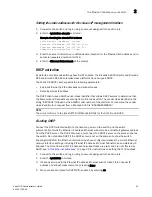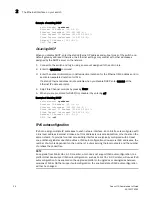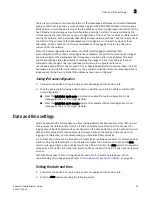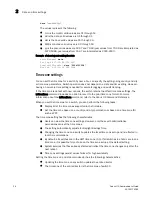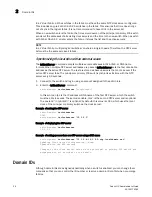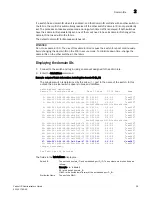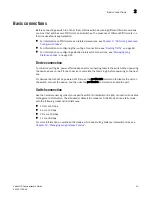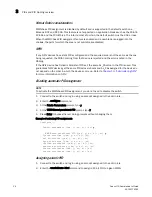
28
Fabric OS Administrator’s Guide
53-1001763-02
Domain IDs
2
In a Virtual Fabric, all the switches in the fabric must have the same NTP clock server configured.
This includes any pre-Fabric OS v6.2.0 switches in the fabric. This ensures that time does not go
out of sync in the logical fabric. It is not recommended to have LOCL in the server list.
When a new switch enters the fabric, the time server daemon of the principal or primary FCS switch
sends out the addresses of all existing clock servers and the time to the new switch. When a switch
with Fabric OS v6.1.0 or later enters the fabric, it stores the list and the active servers.
NOTE
In a Virtual Fabric, multiple logical switches can share a single chassis. Therefore, the NTP server
list must be the same across all fabrics.
Synchronizing the local time with an external source
The tsClockServer command accepts multiple server addresses in IPv4, IPv6, or DNS name
formats. When multiple NTP server addresses are passed, tsClockServer sets the first obtainable
address as the active NTP server. The rest are stored as backup servers that can take over if the
active NTP server fails. The principal or primary FCS switch synchronizes its time with the NTP
server every 64 seconds.
1. Connect to the switch and log in using an account assigned to the admin role.
2. Enter the tsClockServer command:
switch:admin>
tsclockserver
"
<ntp1;ntp2>"
In this syntax,
ntp1
is the IP address or DNS name of the first NTP server, which the switch
must be able to access. The second variable,
ntp2,
is the second NTP server and is optional.
The operand
“<ntp1;ntp2>”
is optional; by default, this value is LOCL, which uses the local
clock of the principal or primary switch as the clock server.
Example of setting the NTP server
switch:admin>
tsclockserver
LOCL
switch:admin>
tsclockserver "10.1.2.3"
Example of displaying the NTP server
switch:admin>
tsclockserver
10.1.2.3
Example of setting up more than one NTP server using a DNS name
switch:admin>
tsclockserver
"10.1.2.4;10.1.2.5;ntp.localdomain.net"
Updating Clock Server configuration...done.
Updated with the NTP servers
Changes to the clock server value on the principal or primary FCS switch are
propagated to all switches in the fabric.
Domain IDs
Although domain IDs are assigned dynamically when a switch is enabled, you can change them
manually so that you can control the ID number or resolve a domain ID conflict when you merge
fabrics.
Summary of Contents for 53-1001763-02
Page 1: ...53 1001763 02 13 September 2010 Fabric OS Administrator s Guide Supporting Fabric OS v6 4 0 ...
Page 4: ...iv Fabric OS Administrator s Guide 53 1001763 02 ...
Page 24: ...xxiv Fabric OS Administrator s Guide 53 1001763 02 ...
Page 28: ...xxviii Fabric OS Administrator s Guide 53 1001763 02 ...
Page 32: ...xxxii Fabric OS Administrator s Guide 53 1001763 02 ...
Page 40: ...xl Fabric OS Administrator s Guide 53 1001763 02 ...
Page 42: ...2 Fabric OS Administrator s Guide 53 1001763 02 ...
Page 54: ...14 Fabric OS Administrator s Guide 53 1001763 02 High availability of daemon processes 1 ...
Page 74: ...34 Fabric OS Administrator s Guide 53 1001763 02 Basic connections 2 ...
Page 102: ...62 Fabric OS Administrator s Guide 53 1001763 02 Audit log configuration 3 ...
Page 214: ...174 Fabric OS Administrator s Guide 53 1001763 02 Management interface security 7 ...
Page 228: ...188 Fabric OS Administrator s Guide 53 1001763 02 Brocade configuration form 8 ...
Page 276: ...236 Fabric OS Administrator s Guide 53 1001763 02 Creating a logical fabric using XISLs 10 ...
Page 404: ...364 Fabric OS Administrator s Guide 53 1001763 02 ...
Page 440: ...400 Fabric OS Administrator s Guide 53 1001763 02 Performance data collection 17 ...
Page 480: ...440 Fabric OS Administrator s Guide 53 1001763 02 F_Port masterless trunking 19 ...
Page 494: ...454 Fabric OS Administrator s Guide 53 1001763 02 Buffer credit recovery 20 ...
Page 574: ...534 Fabric OS Administrator s Guide 53 1001763 02 Hexadecimal overview E ...



